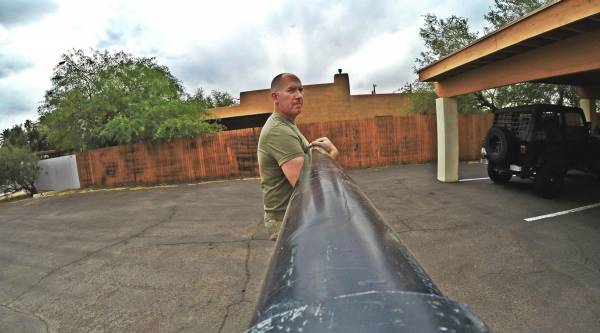Over the last few months, we have looked at a variety of conditioning tools and movements: sledge-hammers and tires, kettlebell snatches, and slosh pipes. Now it’s time to bring them all together into a training program.
Before you get started, I want to emphasize: do not go all out every session.
This is not high-intensity training and you should not need a puke bucket after every workout. This program is about accumulating experience and strength; give yourself time to develop those qualities.
At first, you may find the training a little odd, but soon you’ll find it a refreshing break from normal workouts. It allows you to develop seemingly conflicting qualities at the same time. You will transform gym strength into real-world strength and capability.
Are you ready to rock?
It’s time to transform gym strength into real-world capability.
The Muscles and Might Conditioning Program
The overall program is broken into a pair of two-week blocks that you will rotate for up to 6 months. The first block will build strength, power, and muscle mass, and the second will train work-like scenarios.
Here’s the program in its entirety:
- Block one: Two weeks of the power-strength-hypertrophy routine outlined in my preceding article.
- Block two: Two weeks of Roustabouts (defined below) and Medleys (which I talked about in this article).
Alternate these two blocks for a minimum of three months. Six months is better. Two weeks is an ideal length of time because it allows you to push hard and then switch gears right when your body is asking for a break. Of course, always listen to your body and make adjustments as needed. For more details on why I use the two-week block system, check out Pavel Tsatsouline’s Return of the Kettlebell.
The Roustabout Session
First, lay out your tools and get your body ready:
- Set your kettlebell on the ground, and place your tire and sledge hammer 60ft away from it.
- Put the slosh pipe about one yard from either the hammer or the kettlebell. Which end you start with is your choice.
- Set a clock and warm up for five minutes. I don’t care how, just elevate your body temperature and heart rate. Don’t jump into the workout cold turkey.
Now the fun begins:
- After you feel warm, reset your timer and get ready to roll.
- If you placed the slosh pipe near your tire, grab the sledge and pound out ten hits on the tire (five from each shoulder), log-splitter style. (Click here for a refresher on those.)
- Next, pick up your slosh pipe, cradle it in your arms, and walk to your kettlebell.
- Knock out 5 snatches with your left hand and 5 with your right hand.
- Set your kettlebell down and pick up your slosh pipe.
- Walk back to your tire and repeat the cycle for 5 rounds with as little rest as possible. This should take you about 10-15 minutes. Make sure to record your time in a log book.
This workout is not as easy as it looks on paper. The only rest you get is when you carry the slosh pipe, which isn’t much of a break at all. If you need more than a minute of rest between rounds, you are not in conditioned enough to practice this form of training.
Roustabout Tips
Here are a few ways to get the most from your Roustabout training:
- The carry is your time to recover from the tire hits and snatches, so take advantage of the rest. It will be tough to control that sloshing monstrosity while winded, but you wanted tough, right? You can cuss me out later, I don’t care, just keep tight, suck in the air, and keep moving.
- Don’t let fatigue pull you down into a slumped posture while carrying the pipe. Control your breathing and breathe through your nose. I like to breathe in time with my steps. Keep your entire torso on lockdown, and as Pavel Tsatsouline would say, “breathe behind the shield.”
- Wearing gloves will protect your hands on the tire hits, but strip them off and place them on the tire before you pick up the slosh pipe. That way, when you’re back at the tire you won’t waste time searching for your gloves.
- Recording your time gives you a tool to measure your progress. However, you are not racing the clock. Each sledge hit and snatch should be performed with power and grace. Don’t let fatigue cripple the quality of the movement. If you start to get sloppy, pull the plug. Ugly reps equal injuries and stalled progress.

Keep your breathing under control and your core braced. Control the slosh pipe; don’t let it control you.
Goals and Progressions
Your first goal should be to complete 5 rounds with no rest. Once you can do this, gradually build up to 10 rounds. Once you can complete 10 rounds with no rest, slowly add reps to the sledge hits and snatches. Increase the reps until you are at 10 reps on each side with each implement.
At this level you are performing 200 tire hits, 200 snatches, and 20 slosh pipe carries, and are looking at about 30 minutes of non-stop activity. It’s harder than it looks, so choose your weights conservatively. You should be able to perform this workout comfortably. In time, you will graduate to a heavier sledgehammer and kettlebell. When you do, drop back down to five rounds of five reps per implement and then progress as you did before. This cycle can be repeated for months.
The goal is 10 rounds with the following standards:
- A 10ft slosh pipe with about 4.75 gallons of water (50lbs).
- A 24kb kettlebell for men and a 16kg kettlebell for women.
- A 20lb sledgehammer for men and a 12lb sledgehammer for women.
If you can do more, great, but this gives you a solid goal to shoot for.
The Weekly Schedule
Perform this routine twice per week on Monday and Friday. But wait, what about Wednesday?
Wednesday is reserved for medleys. You remember those don’t you? They’re the basic wall-to-wall carries with various implements or objects. Go re-read this article if you need a reminder. Medley-carries give your body a chance to recover.
Roustabouts will cook your hands, wrists, forearms, and shoulders. You might get pretty sore, so be careful about trying to advance too quickly. Your entire body is dealing with a lot of impact and odd angles. Tissues need time to remodel and adapt, and it will take time for your body to toughen up to this type of training.
If you find that you are too sore to recover before your next session, adapt the program to the following:
- Week 1: Perform the Roustabouts on Monday and Friday and the medleys on Wednesday.
- Week 2: Perform the medleys on Monday and Friday and the Roustabouts on Wednesday.
You can run or hike on your off days, but don’t push too hard. I prefer to take long walks on my in-between days and do hill sprints or go for a strenuous hike on the weekend.
Work Capacity to Tackle Real Life
Endurance sports are fine if that’s what you’re into. But sometimes life has you moving furniture, carrying a heavy pack through the mountains, or pushing a stranded vehicle out of the road. Dealing with an unexpected situation takes more than the endurance you get training for a marathon. It takes work capacity and the ability to move yourself and odd objects with grace, strength, and power.
You want unexpected strength? Then go get some!
More Unusual Methods for Surprising Strength:
- Be Able to Do Everything: Match Your Tool to Your Goal
- The 4-Week Real Strength Squat Routine
- Must-Have Equipment for Strongman Training
- New on Pulse Beat Fit Today
Photos courtesy of Walter J Dorey.






